This article includes a list of general references, but it lacks sufficient corresponding inline citations .(February 2012) |

Frederick William Fairholt (1814 – 3 April 1866) was an English antiquary and wood-engraver. [1]
This article includes a list of general references, but it lacks sufficient corresponding inline citations .(February 2012) |

Frederick William Fairholt (1814 – 3 April 1866) was an English antiquary and wood-engraver. [1]
Fairholt was born in London. His father, who was of a German family (the name was originally Fahrholz), was a tobacco manufacturer, and Frederick was at first employed in the business. He then worked as a drawing-master and later as a scene-painter. Pen and ink copies made by him of figures from William Hogarth's plates led to his being employed by Charles Knight on several of his illustrated publications.
Fairholt's first published literary work was a contribution to Hone's Year-Book in 1831. His life was one of almost uninterrupted quiet labour, carried on until within a few days of death. Several works on civic pageantry and some collections of ancient unpublished songs and dialogues were edited by him for the Percy Society in 1842. In 1844, he was elected fellow of the Society of Antiquaries. He published an edition of the dramatic works of John Lyly in 1858.
His principal works are Tobacco, its History and Association (1859); Gog and Magog (1860); Up the Nile and Home Again (1862); many articles and serials contributed to the Art Journal, some of which were afterwards separately published, as Costume in England (1846); and Dictionary of Terms in Art (1854). These works are illustrated by numerous cuts, drawn on the wood by his own hand. He also illustrated Evans's Coins of the Ancient Britons, Frederic William Madden's Jewish Coinage, Halliwell's folio Shakespeare and his Sir John Maundeville, Charles Roach Smith's Richborough, the Miscellanea Graphica of Lord Londesborough, and many other works.
Fairholt died in 1866 and is buried in Brompton Cemetery, London. [2]
His books relating to Shakespeare were bequeathed to the library at Stratford-on-Avon; those on civic pageantry (between 200 and 300 volumes) to the Society of Antiquaries; his old prints and works on costume to the British Museum; his general library he desired to be sold and the proceeds devoted to the Royal Literary Fund.

John Payne Collier was an English writer, Shakespearean critic, and forger.
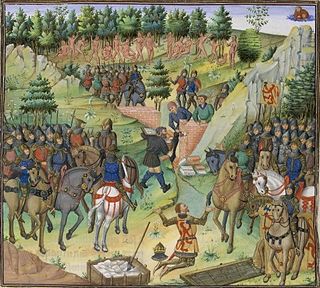
Gog and Magog or Ya'juj and Ma'juj are a pair of names that appear in the Bible and the Qur'an, variously ascribed to individuals, tribes, or lands. In Ezekiel 38, Gog is an individual and Magog is his land. By the time of the New Testament's Revelation 20, Jewish tradition had long since changed Ezekiel's "Gog from Magog" into "Gog and Magog".
Sir Frederic Madden KH was an English palaeographer.

Valentine Cameron Prinsep was a British painter of the Pre-Raphaelite school.
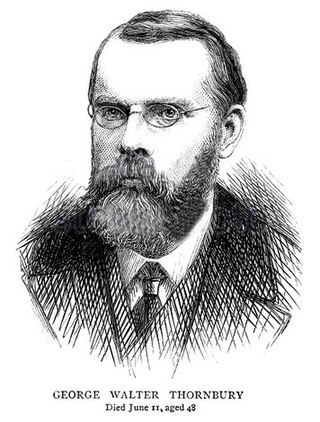
George Walter Thornbury was an English author. He was the first biographer of J. M. W. Turner.

Henry Noel Humphreys (1810–1879), was a British illustrator, naturalist, entomologist, and numismatist.

An anelace was a medieval dagger worn as a gentleman's accoutrement in 14th century England.

Frederick Walker was a British social realist painter and illustrator. He was described by Sir John Everett Millais as "the greatest artist of the century".
Frederic Shoberl (1775–1853), also known as Frederick Schoberl, was an English journalist, editor, translator, writer and illustrator. Shoberl edited Forget-Me-Not, the first literary annual, issued at Christmas "for 1823" and translated The Hunchback of Notre-Dame.
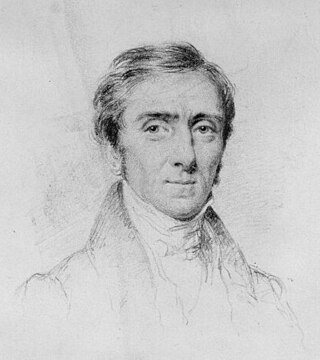
Samuel Weller Singer (1783–1858) was an English author and scholar on the work of William Shakespeare. He is also now remembered as a pioneer historian of card games.

Gogmagog was a legendary giant in Welsh and later English mythology. According to Geoffrey of Monmouth's Historia Regum Britanniae, he was a giant inhabitant of Albion, thrown off a cliff during a wrestling match with Corineus. Gogmagog was the last of the Giants found by Brutus and his men inhabiting the land of Albion.
Allen Robert Branston (1778–1827) known more generally as Robert Branston, was a British wood-engraver.
Mackenzie Edward Charles Walcott (1821–1880) was an English clergyman, known as an ecclesiologist and antiquarian.
Henry Shaw (1800–1873) was an English architectural draughtsman, engraver, illuminator, and antiquary.

John Thomas Dicks (1818–1881) was a publisher in London in the 19th century. He issued popular, affordably priced fiction and drama, such as "shilling Shakespeares and wonderfully cheap reprints of Scott and other standard authors." Earlier in his career he worked with Peter Perring Thoms and George W. M. Reynolds. Employees included illustrator Frederick Gilbert. Readers included Thomas Burt and Havelock Ellis. Dicks retired in the 1870s, when his sons took over the firm which continued into the 1960s.
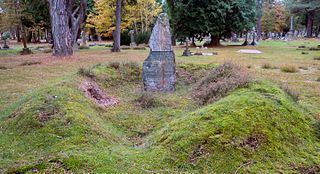
Charles Warne was an English antiquarian and archaeologist who specialized in the prehistoric and ancient monuments of Dorset.

Sir William Shelford (1834–1905) was an English civil engineer.
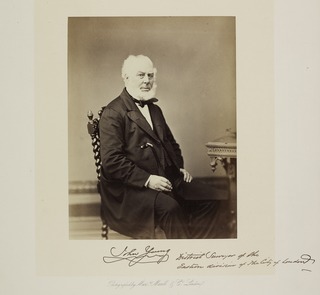
John Young was an English architect and surveyor whose career spanned the grace of the Regency period and the pragmatism of the Industrial Revolution. While based primarily in the City of London, his practice, John Young & Son, Architects, was both eclectic and wide-ranging in South East England. He is particularly noted for his creative use of polychromatic brickwork whether in industrial, civic or residential contexts.
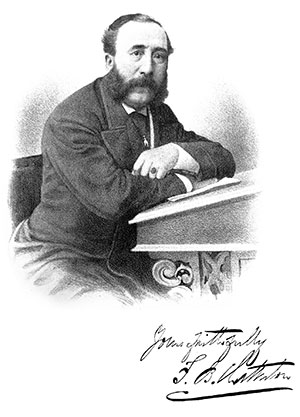
Frederick Balsir Chatterton, known as F. B. Chatterton was a 19th-century British theatre manager and impresario who was lessee of the Theatre Royal in London's Drury Lane from 1866 to 1879. He is credited with originating the famous quote, "Shakespeare spelt ruin and Byron bankruptcy".
Seth William Stevenson was an English antiquarian.